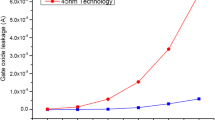Abstract
This paper targets to present energy efficient high speed true single phase clock dynamic circuit design technique, utilizing a novel body biasing tuner. The threshold voltage is controlled dynamically by dint of a novel body bias tuner so that performance of the circuit is enhanced in terms of power, delay, temperature, voltage, noise and corner variations. Power consumption and delay is computed and analysed for wide range of temperature and 40.78–95.5% saving in power delay product is obtained with the same. Quantification of bias voltage variation effect and process corners to find the effectiveness of the proposed design are examined and it is found to be performing consistently as compared with other techniques. Later on bouncing noise analysis is done for the valuation of noise in the circuit. Comparison of power delay product, transistor count and clock phase is done with several previously reported designs. Comprehensive simulation in cadence using 90 nm technology, shows that the proposed design vanquish conventional and other previously reported dynamic circuit design techniques in all aspect of circuit performance. Further, an arithmetic logic unit for measurement using sensors is implemented as a prolongation of the proposed dynamic circuit design technique.













Similar content being viewed by others
References
M. Orshansky, L. Milor, P. Chen, K. Keutzer and C. Hu, Impact of spatial intrachip gate length variability on the performance of high-speed digital circuits, IEEE Trans. Comput. Aided Des. Circuits Syst., 21 (2002) 544–553.
X. Ouyang, C.N. B. Milor and R.F.W. Pease, High-throughput mapping of short range spatial variations using active electrical metrology, IEEE Trans. Semicond. Manuf., 15 (2002) 108–117.
M. Helmy and A. Raouf, Manual/automated capacitance box using Micro-Controller technique, MAPAN-J. Metrol. Soc. India, 26 (2011) 105–113.
H. Gopalakrishnan and W.T. Shiue, Leakage power reduction using self bias transistor in VLSI circuits, Micro. & electron devices IEEE workshop, Boise, USA (2004), 71–74.
Y. Ji-Ren, I. Karlsson and C. Svensson, A ture single-phase-clock dynamic CMOS circuit technique, IEEE J. Solid-State Circuits, 22 (1987) 899–901.
L. Wang, R.K. Krishnamurthyt, K. Soumyanatht and N.R. Shanbhag, An energy efficient leakage tolerant dynamic circuit technique, IEEE conference, Urbana (2002), 221–225.
D. Radhakrishnan, Low-voltage low-power CMOS full adder, IEE Proc.-Circuits Dev. Syst., 148 (2001) 19–24.
J. M. Rabaey, A. Chandrakasan and B. Nikolic, Digital Integrated Circuits, Prentice–Hall of India Private Limited, 2004.
R. Kar, D. Mandal, G. Khetan, S. Meruva, Low power VLSI circuit implementation using mixed static CMOS and domino logic with delay elements, IEEE-SCOReD, Malaysia (2011) 370–374.
Hamid M. Meimand and K. Roy, Diode-footed domino, a leakage-tolerant high fan-in dynamic circuit design style, IEEE Trans. Circuits Syst., 51 (2004) 495-503.
F. Frustaci, P. Corsonello, S. Perri and G. Cocorullo, High performance noise tolerant circuit techniques for CMOS dynamic logic, IET Circuits Dev. Syst., 2 (2008) 537–548.
F. Moradi et. al, Domino logic design for high performance and leakage tolerant applications,” Integr. VLSI J., 46 (2013) 247–254.
A. Dadoria et. al, A novel high-performance leakage-tolerant, wide fan-in domino logic circuit in deep-submicron technology, Sci. Res., 6 (2015) 103–111.
M. Manzoor et. al., Various techniques to overcome noise in dynamic CMOS logic, Int. J. Sci. Technol., 22 (2016) 1–7.
N. Weste, K. Eshraghian and Addison-Wesley, Principles of CMOS VLSI Design, Pearson, 1994, 343–346.
S.M. Kang, Y. Leblebici and C.W. Kim, CMOS digital integrated circuits analysis & design, TMH (2017) 383–387.
B. Razavi, TSPC logic—a circuit for all seasons, IEEE Solid-State Circuits Maga., 8 (2016)10–13.
P. Larsson and C. Svensson, Impact of clock slope on true single phase clocked (TSPC) CMOS circuit, IEEE J. Solid State Circuits, 29 (1994) 723–726.
K.H. Cheng and Y.C.Huang, The non-full voltage swing TSPC (NSTSPC) logic design, IEEE AP-ASIC, Korea (2000) 37–40.
S. Kim, C.H. Ziesler and M.C. Papaeftymiou, A true single phase energy recovery multiplier, IEEE Trans. VLSI Syst., 11 (2003) 194–207.
F.M. Hernandez, M.L. Aranda and V. Champac, Noise tolerance improvement in dynamic CMOS logic circuits, IEE Proc-Circuits Dev. Syst., 153 (2006) 565–573.
A. Asati, Chandrashekhar, A high speed pipelined dynamic circuit implementation using modified TSPC logic design style with improved performance, Int. J. Recent Trends Eng., 1 (2009) 24–27.
P. Sharma, R. Chandel and S. Sarkar, Noise tolerant technique in super and sub-threshold region of TSPC logic, Special Issue of IJCA-ICEICE, 5 (2011) 25–28.
A. Mitra, Design and analysis of low power high speed 1-bit full adder cell based on TSPC logic with multithreshold CMOS, world academy of science, Eng. Technol., 8 (2014) 1–4.
R. Rastogi and S. Pandey, Implementing low power dynamic adder in MTCMOS technology, IEEE-ICECS, Coimbatore (2015) 782–786.
S.-Y. Ahn and K. Cho, Small-swing domino logic based on twist-connected transistors, Electron. Lett., 50 (2014) 1054–1056.
H. Xue, S. Ren, Low power-delay-product dynamic CMOS circuit design techniques, IET-Electron. Lett., 53 (2017) 302–304.
I-Chyn Wey et al., Noise-tolerant dynamic CMOS circuits design by using true single-phase clock latching technique, Wiley Int. J. Circ. Theory Appl., 43 (2015) 854–865.
D. Saikia, P.K. Boruah and U. Sarma, A sensor network to monitor process parameters of fermentation and drying in black tea production, MAPAN-J. Metrol. Soc. India, 30 (2015) 211–219.
G. Lentka, Scalable measurement system for multiple impedance gas sensors, MAPAN-J. Metrol. Soc. India, 3 (2017) 223–228.
A. Srivastava and C. Zang, An adaptive body bias generator for low voltage CMOS VLSI circuits, Int. J. Distrib. Sensor Netw., 4 (2008) 213–222.
Acknowledgement
The authors duly acknowledge with gratitude the support from ministry of Electronics and information technology, Govt. of India, New Delhi, for providing facilities for research, through special Manpower Development Program at National Institute of Technology, Delhi, India.
Author information
Authors and Affiliations
Corresponding author
Rights and permissions
About this article
Cite this article
Verma, P., Pandey, V.S., Sharma, A.K. et al. Estimation and Analysis of Novel Dynamic Body Biased TSPC Design Technique. MAPAN 33, 405–416 (2018). https://doi.org/10.1007/s12647-018-0275-3
Received:
Accepted:
Published:
Issue Date:
DOI: https://doi.org/10.1007/s12647-018-0275-3




